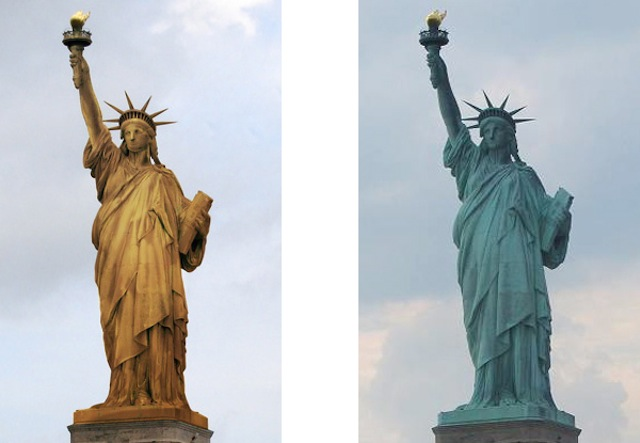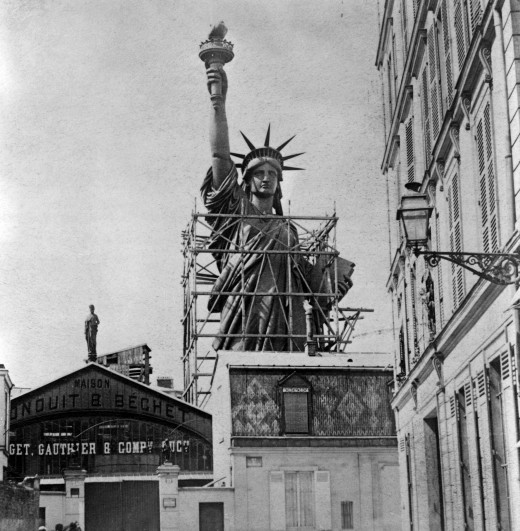The Statue of Liberty, once a symbol of gleaming copper, has undergone a stunning transformation since its completion in 1885. The statue’s striking green hue today is a result of time and nature’s processes, but it’s not just a change in color it’s a protective shield that guards over 100 tons of copper beneath. Here’s a look at how Lady Liberty evolved and what her green patina represents.

The Birth of Lady Liberty: A Copper Icon
In 1885, the Statue of Liberty was completed and presented as a gift from France to the United States. Crafted by Frédéric Auguste Bartholdi, the statue was originally made of copper with a shiny, bright appearance. At 305 feet tall, Lady Liberty symbolized freedom, democracy, and the enduring relationship between France and the United States. The polished copper surface embodied a fresh, hopeful energy, fitting for a new nation.

The Green Patina: Nature’s Work
Over time, exposure to the elements changed the statue’s appearance. By 1920, nature had worked its magic, and the once-shiny copper surface had turned green. This was a result of oxidation when copper reacts with oxygen and moisture in the air, it forms copper carbonate, a greenish-blue layer. While the transformation was gradual, it eventually became one of the statue’s most recognizable features.
Video:
The green transformation-Statue of Liberty’s colorful secret
The green patina that now covers the Statue of Liberty is more than just a cosmetic change. It serves as a protective shield that prevents further oxidation of the copper beneath it. This natural layer helps preserve the statue and maintain its structural integrity, keeping it strong and standing for generations to come.
A Symbol of Resilience and Protection
The transformation from shiny copper to green patina also symbolizes resilience. Just as the statue has withstood the test of time, facing the elements, storms, and even the smog of nearby New York City, the patina signifies the statue’s strength and enduring nature. The protective layer shields the 100 tons of copper underneath, keeping the statue safe from further deterioration. The green hue has come to represent the enduring spirit of liberty and freedom that Lady Liberty has stood for since its unveiling.

Maintaining the Statue: Care and Preservation
Over the years, the Statue of Liberty has required ongoing maintenance and restoration to preserve its integrity. The National Park Service, which is responsible for the statue’s care, has undertaken multiple restoration efforts. The most significant of these took place in the 1980s when the statue’s copper exterior was cleaned, and the internal structure was reinforced. Restoration also included the repair of the statue’s iron framework and the installation of new lighting to improve visibility.
Video:
The History of the Statue of Liberty
The green patina, which now protects the copper, was also maintained during these restoration efforts. While some of the statue’s original surface had to be restored, the patina remained intact to continue its protective role. Today, Lady Liberty’s maintenance includes regular inspections and preservation techniques to ensure that it will continue to stand as a symbol of freedom and hope for many years.
The Statue’s Enduring Legacy
Lady Liberty’s transformation from copper to green reflects the passage of time and the statue’s enduring significance. What began as a bright, shiny symbol of a young nation has evolved into an iconic image known around the world. The green patina that coats Lady Liberty is now inseparable from its identity, symbolizing both the statue’s resilience and its protective qualities.
The statue’s legacy goes beyond its physical form. It represents hope, freedom, and the promise of a better life, and these ideals continue to inspire people from around the world who visit it every year. The green hue has become part of its narrative, reinforcing the strength and timelessness of the symbol it represents.

Conclusion: A Beautiful Symbol of Strength
The transformation of Lady Liberty into the green statue we know today is a testament to both the power of nature and the enduring ideals of freedom. The green patina, while marking the passage of time, continues to serve as a protective shield, preserving the statue’s copper structure beneath. Over 100 tons of copper remain safeguarded by this layer, allowing the Statue of Liberty to stand tall and strong for generations to come. Lady Liberty’s green hue is not just beautiful it’s a symbol of the resilience, protection, and unwavering spirit that she represents.



